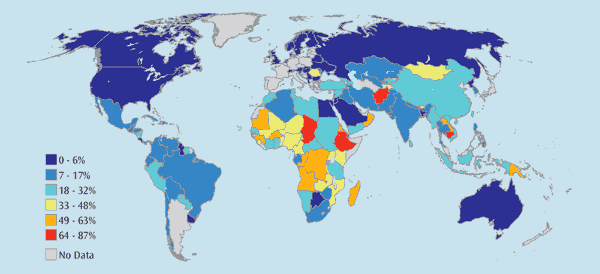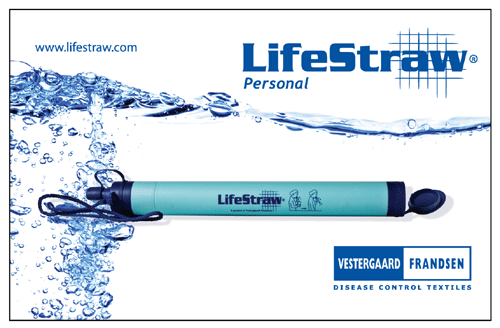The LifeStraw® Water
Filtration System

Over 70% of Earth’s surface is covered in water, and although this seems like a lot, only
2.5% is considered freshwater. That means that <1% of the world's freshwater (~0.007% of all water on earth) is accessible for direct human uses. Earth’s freshwater supply is decreasing rapidly due to climate
change. Many aquifers have been over-pumped and are not recharging as rapidly as in the past. Although the total fresh water supply has not been depleted, much has become polluted, salted, unsuitable or otherwise unavailable for drinking, and/or use in industry and agriculture. Low income nations are especially vulnerable to water scarcity; an estimated 884 million people in the world, 37% of whom live in Sub-Saharan Africa, still use unimproved sources of drinking water.
 |
| Percentage of the population without reasonable access to safe drinking water |
 |
LifeStraw® is a portable personal water filter system that was invented by a Swiss public health company called Vestergaard-Frandsen in 2005. The filter was originally developed for natural disasters and has since been deployed to almost every major natural disaster. LifeStraw® has been a life-saving innovation for the millions of people in the developing world who lack access to clean and safe drinking water. LifeStraw® has won a number of prestigious awards (including Best Invention of 2005 by Time Magazine) for its unique design and functionality.
Mikkel
Vestergaard Frandsen is the CEO and owner of Vestergaard Frandsen. The company
is focused on achieving the United Nations’ Millennium Development Goals;
specifically the prevention of infectious diseases, and has made significant
contributions in the fields of global water and food security, as well as
climate change mitigation. The LifeStraw® is a result of Vestergaard Frandsen’s
more than 10-year long association with The Carter Center, an aid organization
set up by former U.S. President Jimmy Carter, which runs a program called
Global 2000 aimed at eradicating the Guinea worm disease.
 |
| Mikkel Vestergaard Frandsen |
 LifeStraw® is a
very simple and easy-to-use mechanism. Made from durable plastic, it contains
no chemicals or iodinated resin, has no batteries and no moving parts that can
break or wear out. LifeStraw® is tube
shaped and approximately 9” long and 1” around with a string attached so that
users can wear it around their neck. To use, the LifeStraw® is inserted
directly into the water source and then the user takes a sip just as they would
from a straw. Water is forced through a series of hollow fibers that contain
pores that are less than 0.2 microns across.
LifeStraw® is a
very simple and easy-to-use mechanism. Made from durable plastic, it contains
no chemicals or iodinated resin, has no batteries and no moving parts that can
break or wear out. LifeStraw® is tube
shaped and approximately 9” long and 1” around with a string attached so that
users can wear it around their neck. To use, the LifeStraw® is inserted
directly into the water source and then the user takes a sip just as they would
from a straw. Water is forced through a series of hollow fibers that contain
pores that are less than 0.2 microns across. |
| LifeStraw® |
 The LifeStraw®
microfiltration system is capable of keeping out dirt, parasites and bacteria
to allow clean water into the user’s mouth. Independent testing at theUniversity of Arizona showed that LifeStraw® exceeds the EPA requirements of
reduction for bacteria and protozoan parasites. Bacteria removed include:
Escherichia coli (“E. Coli”), Campylobacter, Vibrio cholerae (“Cholera”) . While LifeStraw® effectively filters out 99.9999% of bacteria and 99.9%
of parasites, it is only effective in filtering out particles that are .2
microns or bigger. At this time, LifeStraw® cannot
filter out heavy chemicals or salt.
The LifeStraw®
microfiltration system is capable of keeping out dirt, parasites and bacteria
to allow clean water into the user’s mouth. Independent testing at theUniversity of Arizona showed that LifeStraw® exceeds the EPA requirements of
reduction for bacteria and protozoan parasites. Bacteria removed include:
Escherichia coli (“E. Coli”), Campylobacter, Vibrio cholerae (“Cholera”) . While LifeStraw® effectively filters out 99.9999% of bacteria and 99.9%
of parasites, it is only effective in filtering out particles that are .2
microns or bigger. At this time, LifeStraw® cannot
filter out heavy chemicals or salt.  |
| LifeStraw® Family |
In addition to LifeStraw®,
Vestergaard Frandsen now offers LifeStraw® Family. This product is made to
filter, on average 10 liters of water in an hour, and 18,000 liter of water
within its life cycle. Water is poured into the pre-filter bucket, where the
water will be first filtered through the pre-filter textile in order to remove
any thick and course gunk. Then the water will eventually reach the capillary
membrane, where bacteria, viruses, parasites, and dirt will be filtered out,
and then out comes the clean water. The main driver for filtration is gravity.
It was also stated that a small amount of chlorine is used to keep the
membranes from fouling. Just as with LifeStraw®, this filtration system, also
filters out 99.99% of bacteria out with its densely packed capillary membranes.
The downside to both products is that it doesn't filter out chemical wastes.
Therefore, in industrializing countries this may not be a solution, but for
developing countries it is one way of insuring clean water.
 |
| LifeStraw® Family demonstration |
LifeStraw® is available for
retail sale all over the world; in middle and high income countries such as the United States, Canada, Australia,
and some countries in Europe the LifeStraw® is used by people that like to
travel, go hiking and camping.
However, the majorities of purchases of
LifeStraw® are made by ministries of health, NGO’s and non-profit organizations such as the Red Cross, WorldServe, the UN Children’s Fund (UNICEF), Rotary International and IMA World Health and are distributed as part of public health campaigns or in response to
complex emergencies.
While LifeStraw® has significantly reduced the amount of water-borne diseases for many developing
nations, Vestergaard Frandsen has received some criticism for its LifeStraw®
products, claiming that LifeStraw® is merely a short term solution to a much larger issue,
and that attention needs to be focused on providing developing nations with
better water infrastructure and governmental policy. Other complaints
surround the cost of the product, saying that the cost is too high for the targeted market.
Examples of LifeStraw® in use:
This Post has been provided by the group, Insomniacs:
Chris Baker, Kimberly Dixon, Takumi
Suzuki, Hung Tram, and George Win
for Global Health 444U Summer 2013 Dr. Richardson
I really enjoyed your presentation this morning. I never knew about this device or anything like it existed before today. Also, the conversation regarding the carbon credits was inspiring. It made me want to further explore the criticisms regarding this business and others like it because my initial thought is that the criticisms seem misplaced or even counterintuitive. Thanks for the information! Well done Insomniacs! SH
ReplyDeleteI like the map your group has with the information on LifeStraw because it gives a visual to show the parts of the world without access to clean water (mainly regions in Africa). When I clicked on it and and followed the link, it was very similar to the World Life Expectancy map. Although there are many other correlations to life expectancy, water is a crucial source to all life. In regards to LifeStraw, I am impressed with the technology in that it filters 99.9% of bacteria including E.Coli and Cholera. That is really impressive to me. I think it is great that something so simple can make such a powerful impact.
ReplyDeleteI'm slightly confused. In the first paragraph you said that more than 1% (>1%) of the world's freshwater is drinkable. Did you mean less than (<1%)?
ReplyDeleteOther than that, the LifeStraw is kind of a super amazing thing and I had no idea it existed. I've heard of other ways to filter the water, but this seems to be the simplest.
This is awesome! I enjoy learning about innovative solutions to such basic public health issue. Your team did an awesome job presenting! The graphics are attention-grabbing and informative.
ReplyDelete